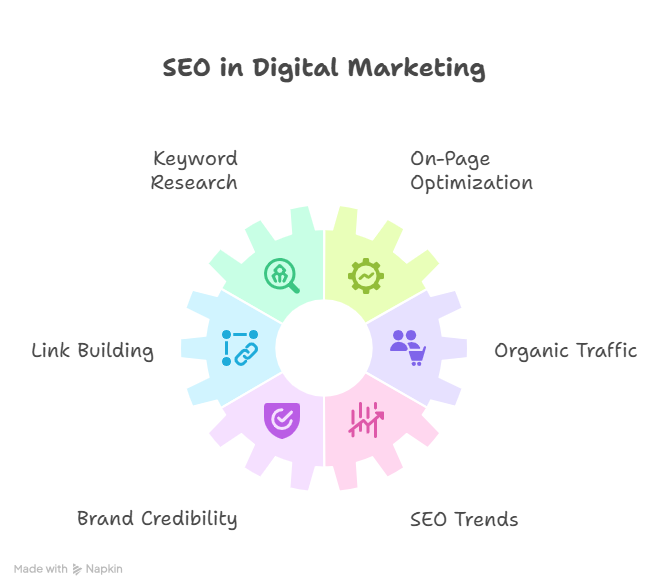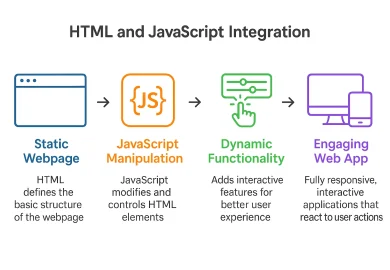Introduction
Sixty percent of marketers say improving their SEO practices and increasing their organic presence is the top priority for 2025. Almost 70% of search engine results are from organic listings, and 53% of website traffic comes from the search engine algorithms.
Whether shopping, learning, or researching, almost 88% of online experiences start with a simple keyword typing into the search box, still in 2025, there are millions of companies that struggle to make their brand visibility due to their struggles to land their page on top of the search results, low competitive ads, and limited knowledge on content marketing strategies. If you are also facing this issue, the standard solution for struggling with visibility is understanding SEO in digital marketing. This article provides a comprehensive understanding of SEO for digital marketing success in today’s fast-paced digital world.
In 2025, SEO is the foundation for digital marketing practices to improve brand visibility and also helps integrate with email marketing and social media to rank higher in search results.
What is SEO?
SEO is the digital marketing practice of making your website or brand’s visibility appear organically in search engine results. The better the SEO practices, the higher the chances of being featured in the top search engine results.
How Search Engines Work
When a search query is entered on search bars, the search engine uses web crawlers, automated bots, to discover pages throughout the internet. These search results are indexed and stored in a database. Based on the hundreds of search engine algorithms that utilize relevance, authority, and visibility, the search engine ranks the indexed content and determines the display order for the search results.
For a deeper understanding of SEO fundamentals, Google’s own SEO Starter Guide is an excellent resource that covers best practices for optimizing your site.
Organic vs Paid Search Results
Organic search results are based on relevance and search engine optimization (SEO) performance. It increases traffic over time and also builds trust among the users. However, paid search results are sponsored results at the top, and they also disappear from the results once you stop paying for them.
Why SEO is essential in Digital Marketing
SEO is the backbone of digital marketing, helping businesses improve their online visibility, attract organic traffic, build credibility, and achieve long-term growth—all without relying heavily on paid advertising. In 2025, mastering SEO is no longer optional, but essential for digital success.
| Channel | Traffic Holding | Cost over time | Average ROI |
| SEO | Permanent | Economical | High |
| PPC | Temporary | Expensive | Medium |
| Social media Ads | Up to certain period of time | Moderate | Medium |
Long-term Brand Building Benefits
SEO is not only about improving traffic but also about building trust among users. Making your brand appear at the top of the search results gives it authority, which encourages users to make repeat visits and fosters customer loyalty.
SEO’s Impact on Customer Journey
SEO builds confidence and awareness among customers. This enables the leads to convert into loyal customers.
How SEO Works – The Complete Process
Understanding the mechanism of SEO helps marketers clarify how search engines estimate and rank content.
Search Engine Crawling and Indexing
The content must be crawlable and indexable to rank higher in search engines. It is done by submitting the XML sitemaps, fixing robots.txt, and removing duplicate URLS.
Ranking Factors and Algorithm Basics
Google has nearly 200 ranking factors, including page speed, backlinks, mobile usability, Content quality, user experience, website authority, and more. The search algorithm evolves, prioritizing user-centric performance and relevance as of 2025.
The Role of Keywords in SEO
The keywords connect the user searches with the content on the Internet. The search engine algorithm mainly uses keywords to understand the intent behind the search and delivers high-quality results. Hence, Keyword optimization increases the likelihood of ranking higher in search results.
Content Quality and Relevance Signals
The content should be unique and original, with comprehensive and helpful information, and created by knowledgeable and credible sources. It should demonstrate E-A-T(Expertise, Authoritativeness, Trustworthiness). To receive relevant signals from the search engine, Content should be regularly updated to keep the information fresh and accurate.
Technical and User Experience Factors
Technical factors and user experience also significantly impact SEO. Some of the technical aspects are site architecture, core web vitals, page speed, mobile friendliness, https encryption, schema markup, smooth UX, and fast server response.
Types of SEO in Digital Marketing
On Page SEO Fundamentals
On-page SEO involves optimizing every web page to attract relevant traffic from search engines. The optimizing elements include title tags and meta descriptions, Image optimization, Internal linking, Readability, URL structure, content Quality and depth, Header Tags, and Keyword integration. One can use Yoast SEO and Surfer SEO tools for on-page SEO.
Off-Page SEO and Link Building
It refers to the work done outside your website to impact the rankings. It helps to optimize high-quality backlinks, influencer outreach, social signals, brand mentions, and authority building. By installing Ahrefs or Semrush, one can achieve off-page SEO more easily.
Technical SEO Basics
The search engine will check for site speed optimization, XML sitemaps, robots.txt files, SSL certificates, Schema markup, Crawl errors and broken links, duplicate content issues, clean URL structures, and core web vitals scores. This helps your website crawl, index, and be understood more easily, allowing it to rank higher in search results.
Local SEO for Businesses
Local SEO focuses on a website’s online presence within a specific geographical area. Google Business Profile optimization, local citations, local keyword research, location-specific content, and online reviews and feedback are used to increase the chances of more traffic to the website.
Mobile SEO optimization
To reach more potential customers, websites should be optimized for mobile-friendliness. The design is adaptable to all screen sizes, with faster loading times on mobile devices. Users should experience readable fonts and images with more straightforward navigation. Pop-ups that obscure content should be avoided on mobile.
Voice Search SEO
People usually speak differently from what they type. So the website is optimized for target conversational keywords, long-tail keyword focus, local seo integration, and answers questions directly. For example, creating FAQ questions with optimized question-based keywords that answer common questions in a conversational tone.
SEO vs Other Digital Marketing Channels
Table 2 : Comparison of SEO with other Digital Marketing Channels
| Channel Comparison | SEO | SEM | PPC | Social Media | Content Marketing |
| Cost | Low media cost; requires initial investment in time/resources | Medium Pay per click; scales linearly with ongoing budget | High Pay per click; scales linearly with ongoing budget | Needs creative production with money spent on ads | Similar to SEO but varies |
| Time to results | 3-6 months | Immediate | Immediate | Hours-Days | Months |
| Targeting Audience | Intent based | Intent Based | Broad | Interest based | Intent + Interest based |
| Integration Strategy | Base or Foundational layer | Amplification | Supplement | Awareness & Research | Collaborating layer |
| Suitable for | Sustainable traffic and brand trust | Short – term promotions | Short- term promotions | Community awareness | Authority and Nurturing |
When to use each channel (Decision Tree Concept)
- If we want to launch a product and need immediate results, we can consider PPC.
- SEO is used to build long-term authority and generate consistent, free traffic.
- If we want to build a community for our brand, we can consider Social Media Marketing.
- If the channel wishes to provide knowledgeable information and build thought leadership, we can consider Content Marketing.
SEO Benefits for Businesses
Apart from brand visibility, SEO also provides tangible benefits that directly affect the business marketing strategy.
- Increased Website Traffic and Visibility – 68% of clicks go to the top three organic results.
- Cost-Effective Marketing Investment – SEO doesn’t require spending on clicks
- Better User Experience and Engagement – It lowers bounce and improves lead conversion.
- Competitive Advantage in search – SERP outperforms the competitors who rely on ads.
- Measurable Results and Analytics – Google Search Console and Semrush provide analytics on clicks, impressions, views, and more.
SEO Trends and Updates for 2025
- AI and Search Generative Experience Impact – Provides comprehensive, authoritative and unique content that is optimized for refinement queries.
- Core Web Vitals and Page Experience – Provides visual stability and responsiveness with excellent loading speed.
- E-A-T(Experience, Expertise, Authoritativeness, Trustworthiness) – Useful for creating helpful and accurate content.
- Voice Search and Conversational Queries – Provides answers to common questions with long tail and conversational keywords.
- Mobile-First and Core Web Vitals – Provides seamless and fast response on smartphones and tablets.
Common SEO Mistakes to Avoid
- Keyword Stuffing and Over Optimization – Search engines easily find out this and may penalize your site.
- Ignoring Technical SEO issues – Even greater content fails to rank without technical SEO.
- Poor Content quality and Relevance – Always, priority is given to providing high-quality, valuable, and updated content to the audience.
- Neglecting Mobile optimization – Fails to reach more customers in this mobile-first world.
- Not Tracking and Measuring Results – we make blind moves without knowing where to adjust our strategy.
Getting Started with SEO: Step-by-Step Guide
SEO Audit: Analyzing Your Current State
Evaluate Keyword usage, header structure, meta tags and description, backlink profiles quality and relevance, crawl errors, site speed, SSL certificates, mobile friendliness, indexing issues, and top organic competitors.
Keyword Research and Strategy
Prioritize high-volume, low-competition, and high-intent keywords. Understands the need for a search with specific terms. Utilize practical tools to identify specific competitor keywords.
On-Page Optimization Checklist
Write an engaging meta description and a compelling Title tag. Use a single H1 tag and structure content with H2s, H3s, and so on. Optimize Images and ensure readability with integrated keywords. Add internal links related to your site.
Content Creation and Optimization
Prioritize E-A-T and develop a content calendar for consistent optimization. Updates the existing content regularly to keep the information fresh and relevant.
Tracking Progress and Results
Utilize Google Search Console to analyze the indexing status, crawl errors, track keyword rankings, key performance indicators, user behaviors, conversion, and position for target keywords.
SEO Tools and Resources
Free SEO Tools Every Marketer should use – Google Search console, Keyword Planner, Google Analytics, Google Trends, Yoast SEO/Rank Math.
Table 3. Premium SEO Platforms Comparison
| Tool | Suitable for |
| Semrush | Competitive Analysis |
| SurferSEO | Content Optimization |
| Ahrefs | Backlink Tracking |
Google’s Essential SEO Tools – Google Search Console, Google Analytics 4, Google Keyword Planner, Google Business Profile for Local SEO.
SEO Learning Resources and Communities – Ahrefs Blog and YouTube Channel, SEO communities, Moz Blog and Learning Center, Google’s SEO Starter Guide.
Measuring SEO Success
- Key Performance Indicators (KPIs) for SEO – Keyword Rankings, Backlinks, Core Web Vitals Scores, Number of Indexed pages, Bounce Rate, Organic Click through rate.
- Setting Up SEO Tracking and Analytics – Install Google Analytics 4 and set up goals/conversions in GA4. Integrate with SEO Tools.
- Interpreting SEO Data and Reports – Use dashboards and comparative analytics, look for correlations with algorithm update dates.
- ROI Calculation for SEO campaigns – (Organic revenue – SEO costs) / SEO costs.
Conclusions and Next Steps
SEO increases organic traffic by optimizing search engine results, measuring success with relevant KPIs. This data analysis drives continuous improvement. In order to put SEO in practice, you should conduct an SEO audit, prioritize keyword research, build high-quality backlinks, and address the technical SEO issues. Invest in SEO tools to streamline research and online courses from reputable platforms, such as Tutedude, on specific SEO topics. Attend industry webinars and conferences to stay informed. Are you ready to start your SEO journey today? Explore our comprehensive SEO courses for your specific SEO needs.





